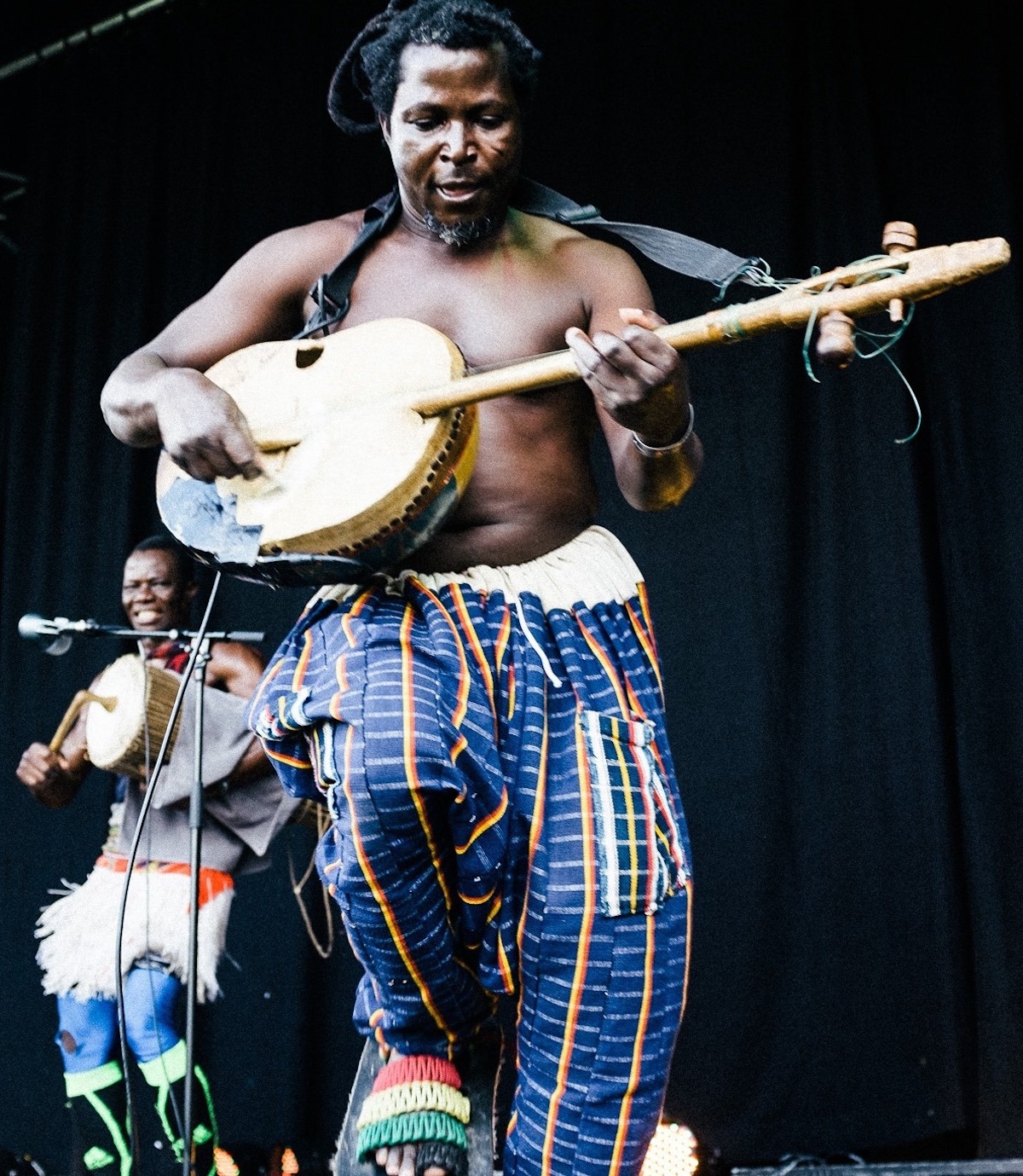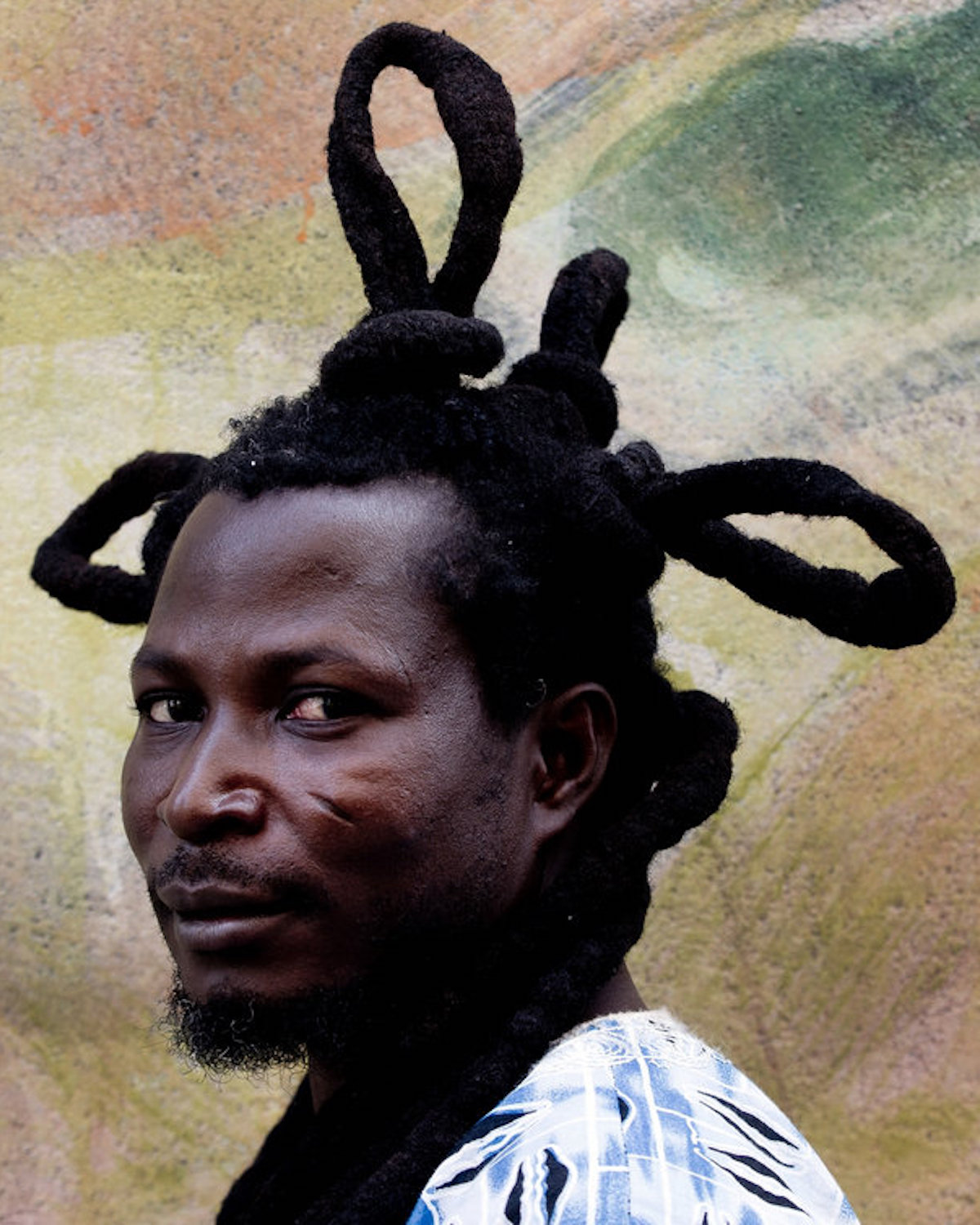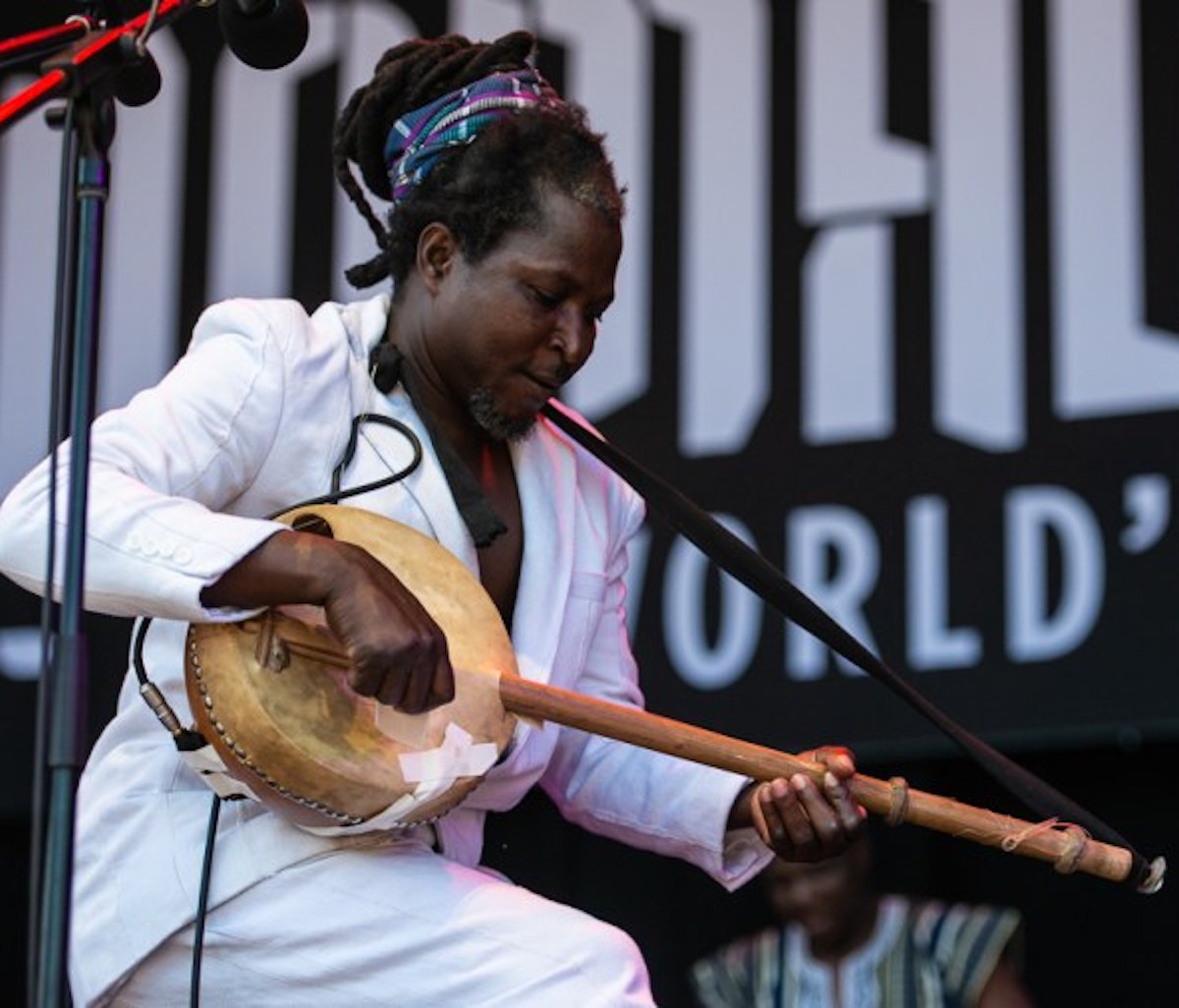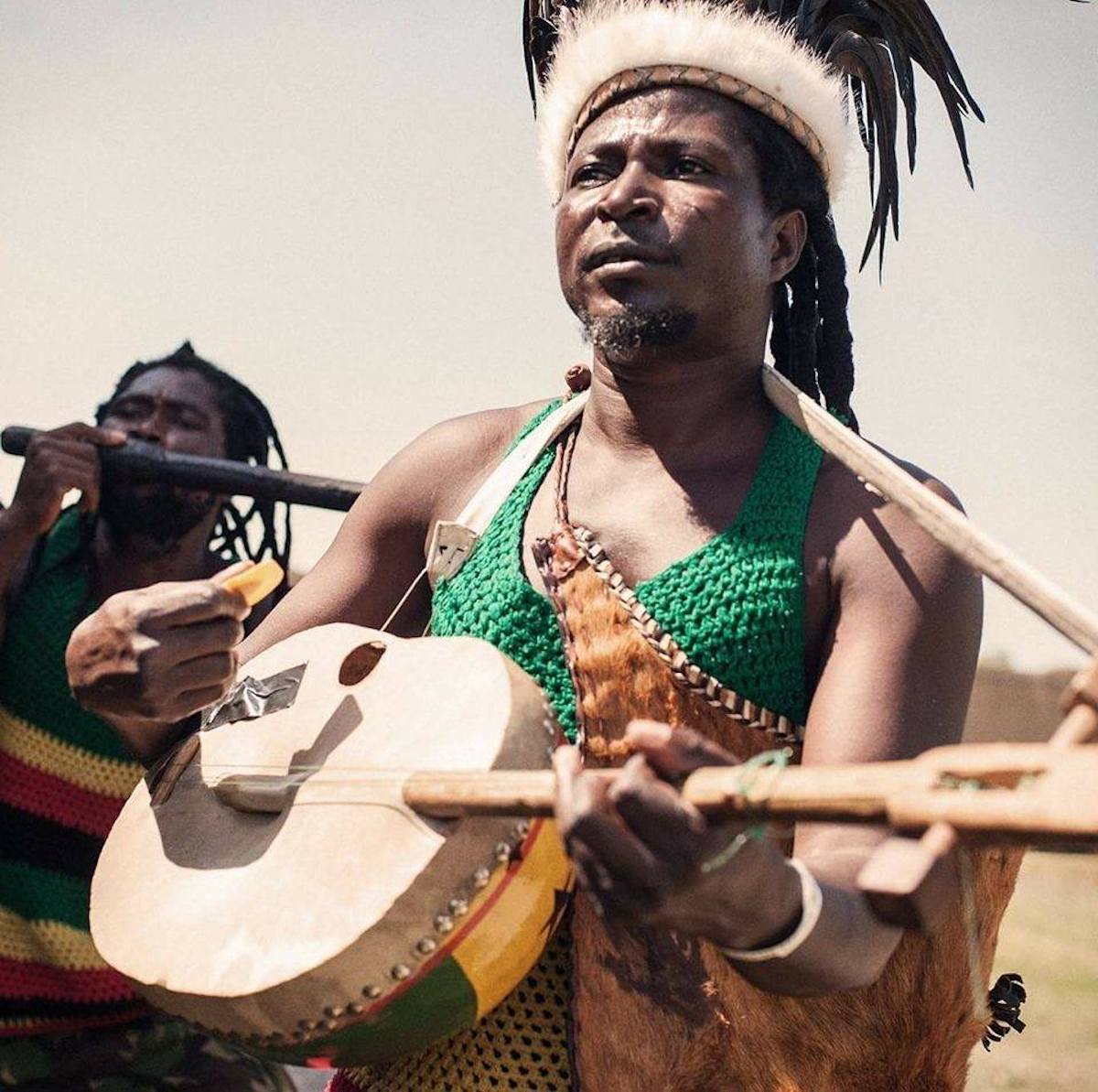THE EDITED PRESS RELEASE: “Work Hard solidifies King Ayisoba’s reputation as both a shamanic performer and a restless sonic experimenter. The album is a wild mashup of Ayisoba’s frenetic kologo sound and musical deep dives from an exciting roster of Ghanaian producers and contributors — all curated and partially mixed by Zea from post-punk legends The Ex.
How does modern pop music reflect its surroundings? Given so many artists often find themselves in in-between states, decamped in airport lounges on their way to somewhere else, the idea of one record successfully capturing the magic of two places separated by thousands of miles, may sound like a contradiction in terms. But this is what happened with Work Hard.
The album has a different focus than his previous releases. This was partly due to the disruptions and adjustments that Covid brought in its wake, which in turn necessitated a more homegrown strategy. The bulk of the recording and mixing was done at Top Link, Francis Ayamga’s hilltop studio in Bongo, a town in the Upper East Region of Ghana bordering Burkina Faso. Francis has become an in-demand producer, due mainly to his previous work with Ayisoba, a relationship that also packed in a European tour as part of the King’s band, playing the djembe and bembe drums. Francis has thrown himself into curating as much of the local music scene as possible, producing This is FraFra Power (2019), released on Makkum Records, the label of key Ayisoba collaborator Zea, aka Arnold de Boer. De Boer, who mixed two tracks and did the mastering (as well as adding vocals and guitar parts), talked of how some of the “Glocal” sounds on King Ayisoba’s new record initially came to pass. The record’s core playfulness, brilliantly captured by Ayamga, could be a spirit conjured up whilst playing live back in 2019, when Zea and Oscar Jan Hoogland toured with King Ayisoba, Ayuune Sule, Atamina, Prince Buju and others, “in a big bus driving through the country: A West African Magical Mystery Tour.” De Boer: “Ayisoba said he’d like to ‘chop’ some of my beats with the band. We tried it, then he and Francis started working on things. Sometimes beats went first, sometimes the other way round, but always around the groove of the band. Ayisoba believed he’d show that the (local) tradition was more powerful.”

Francis and his studio also star in the first video culled from Work Hard, the sassy Bossi Labome. The family feel projected by the video reflects the fact that the studio has become a vibrant center for the locals, where young kids hang around outside waiting for an opportunity to drop their lyrics, raps and songs on some of the beats Ayamga produces. Tracks are often adorned with digital candy courtesy of Fruity Loops and Cubase, two programs that often inform the sound of contemporary African pop. The studio is also a magnet for national and some international artists such as Bonjo from African Head Charge. Unlike his previous album, 2017’s 1000 Can Die, Work Hard showcases no guest musicians such as Lee Perry, but De Boer sees the local involvement creating a practice akin to that nurtured at the Black Ark studios, both in terms of vibe and operation.
As noted earlier, Zea throws a rope bridge to another creative hub with its roots firmly planted in the local community, Katzwijn Studios in Voorhout; a place quietly ensconced in the bollenstreek of South Holland. One of the last bastions of the Dutch underground and home to a number of creative endeavors (including a brewery), the activity centered around Katzwijm has often informed, and in some cases openly guided, the past decade’s resurgence in Dutch alternative guitar music. Ayisoba sees Katzwijm as a home from home, having recorded a great deal of 1000 Can Die there. For Work Hard, Ayisoba recorded one mid-tour track in this magical converted old bulb shed, the glorious People Talk Too Much. De Boer again: “That song was recorded in 2017 at Katzwijm. I only play guitar. And it’s almost the whole band taking a turn ‘talking’! You hear them in this order: King Ayisoba, Ayuune Sule, Adortanga (who also plays the Do, the traditional hunting horn) and Jamaica (real name Abobe Azure), the drummer in the band. All sing in Frafra. Francis Ayamga made the beat, and I produced, edited, mixed and mastered the song.”
Despite having a foot in two continents, the album is perhaps Ayisoba’s most consistent, “concentrated” release. For one, there is a strong guiding spirit throughout that maybe looks to give a pep talk to his own community. The sleeve notes and lyrics, in Frafra, Twi, or the King’s own style of pidgin English, are strident and sometimes mischievous statements, dealing with uncomfortable issues many often prefer to ignore in an increasingly cloistered West. Ayisoba’s commanding personality shines through as a king prepared to tackle matters head on.

Brought in in regal style by the repeated line, “Be together,” Good Things God Knows lays down the law in no uncertain manner. The admonishing of wicked leaders — a recurring theme with Ayisoba — is the central message, but rather than let us mortals do the heavy lifting, Ayisoba warns that judgement will be revealed in the presence of The Lord. Rappers and dance hall artists, Ras Kukuu and Twinkle, add some supporting texts. Though what with the children’s voices and flute, this sounds such a joyful summary of God’s omnipotence, that when words like corruption and chaos are levelled at “African leaders”, it’s hard to feel repentant.
Bossi Labome continues to walk the tightrope between an upbeat musical tone and a serious message, this time a song warning about adultery among the Frafra people of Northern Ghana. It’s worth noting that King Ayisoba uses the song to address the unequal position of women and how they are treated, punished even, when they commit adultery. Sadly men often get away with adultery, and are even praised by their peers when dating other married women. The sleeve notes highlight some accepted views in society; which Ayisoba says is very real in Ghana. But, as he says, “It doesn’t have to be like this!” The video shows the traditional women group Sugri Hajia Zenabu Group from Bongo, who lend their vocal support to the King’s message. Group leader Zenabu — a matriarch adored by the King — also sings on the chorus of the track. Some glorious slinky rhythms get a chance to weave through the song, a simple but groovy call-and-answer number which flits between the heartfelt delivery of Awilo One and Ayisoba. The rumbling bass and kologo scratches are the other orchestrators of the vibe. And … is that really the sound of a whip? The video is a scene setter and a mnemonic for what’s been going on in Ayisoba’s life these last few years: we see Francis mixing, the local women laying down the message and Ayisoba guiding matters.
Following Bossi Labome we have People Talk Too Much: Sing Hosanna, finally someone says it! One of the great strengths of Ayisoba’s music is the manner in which he delivers a simple and often devastatingly obvious message. People indeed, “talk too much” and “seeing what happens” is the great antidote. The song title, doled out by Ayisoba at regular intervals, acts as a rallying point, akin to a Maypole where dancers can adorn the ceremony all they want, without, of course, straying too far from the central point. More instructions are doled out by the following two tracks: Namba Sonne is an instruction manual on how to be a good king. The texts are delivered by Atamina, and fully in tune with the sacred role that a king must adopt towards his subjects. The music feels both mystic and urgent, and yet at one remove.

This is a deep dive into another consciousness; essentially an oral instruction manual; the instructions held aloft by a rhythm and a bewitching flute line. Tribe reminds us it’s vital to learn our own local language. Taking on ignorance and elite disdain all at once, the celebratory tone is bolstered by some soulful brass stabs that appear at the end of each melody-message. The track starts to become slightly psychedelic courtesy of some tricksy and ever-so-slightly vocoded backing vocals, which are reminiscent of the foxy vox on Funkadelic’s mid-1970s records. Watch out for the great synth fade-out, too.
The record never gives up its urgent pace. Adinooma sounds like a stadium rally, with Ayisoba seemingly announcing it through a loudhailer. This is no coincidence, as the track is about the importance of keeping fit and eating healthily: with Ayisoba also taking the lesson to heart. It’s a classic Ayisoba track, in that these are aspirational songs, maybe reflective of the issues in his own life, but magnified outwards in order to help the wider community. For its part, ‘Abome’ sits atop a brilliant, bouncing electro polyrhythm and tells the parable of the rat and the hunter. Cautionary in tone, the track warns us not to swallow every hard luck tale you hear, as you could inherit the enemies of others. The shuddering polyrhythms, seemingly changing direction now and then, are maybe there to soundtrack your own caution.
Work Hard, despite its title, is a pop record at heart. Some of the aspirational elements of pop music come home to roost on Kokoko Enter, a joyous track and possibly the LP’s best, even if the lyrics deal with another weighty political matter. Here we learn that effective border controls are needed to stop dangerous criminals entering Ghana. It’s a bit hard to square that message with the glorious melody and call-and-answer vocals. There are also some beautiful synthesized brass sounds and a steel band sample from Fruity Loops which, when allied to the deeply wobbling beat and explosive sampled local drum fills, have a distinctively ravey quality. The track’s mixer and master-in-chief de Boer adds one of his classic, inquisitive guitar lines, and the falsetto Enter Enter Enter vocal. Last track Buri Malima is based around a rolling set of rhythms, not surprising seeing as it promotes the role of traditional cultures. We hear a local horn and talking drum group, Kuul Kanarise / Gulkanates, who play at the enthronement of kings and queens and receive animals for their labour. The flute makes a welcome reappearance sketching out aspects of the melody and the regal blaring of a traditional lute, kalebas and goatskin, and a string instrument called a Goje (played with a bow) bring matters to a close.”












































